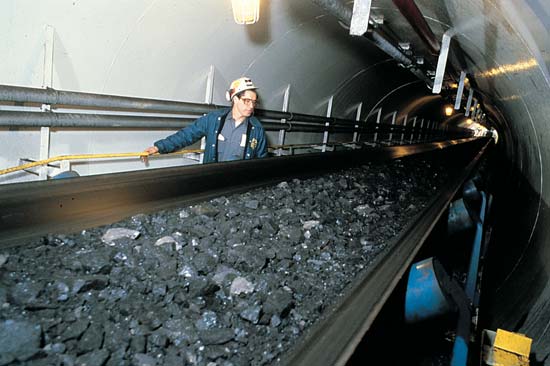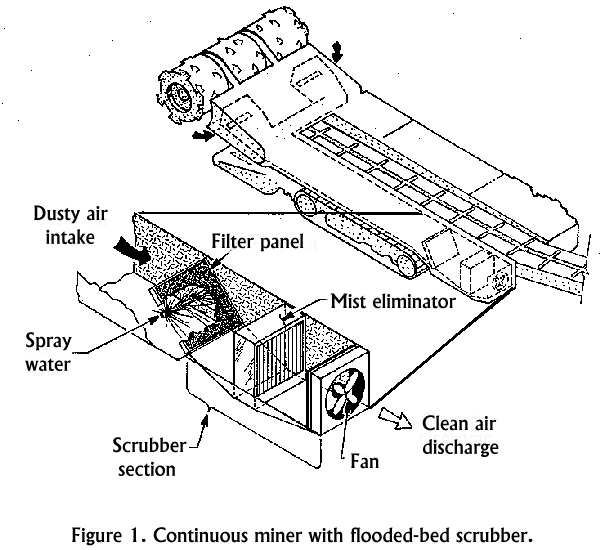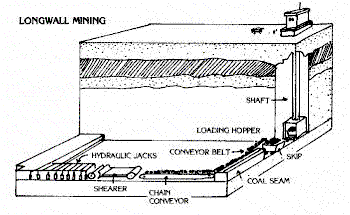What is Mining?
What is Mining?
 An aerial view of an open-pit copper mine in Arizona shows how vast an area a surface-mining operation covers and the depth, after terracing, that such a mine can attain. - Donovan Reese/Tony Stone Images
An aerial view of an open-pit copper mine in Arizona shows how vast an area a surface-mining operation covers and the depth, after terracing, that such a mine can attain. - Donovan Reese/Tony Stone ImagesThe branch of industry concerned with the search for, and extraction of, minerals from the Earth is called mining. The site in which minerals are found is usually called a mine—two exceptions are oil wells and rock quarries. The kinds of minerals dug from the Earth vary widely. They include the ores of iron, aluminum, chromium, tungsten, gold, silver, copper, coal, diamonds, lead, nickel, platinum, tin, and zinc. Some of the less familiar products taken from mines are arsenic, antimony, asphalt, cobalt, molybdenum, sulfur, and vanadium. These and other minerals have, for 6,000 years, provided the raw materials by which human civilizations have been built. Today, apart from food, paper, and some clothing, there is hardly a product that is not derived from the Earth's store of minerals. Nearly every building in modern industrial societies such as Canada, Japan, Germany, and the United States is constructed primarily from processed raw materials dug out of the ground. Highways are paved with asphalt and the cars, trucks, and buses that ride on them are made mostly from steel and other metals. Appliances such as radios, television sets, telephones, toasters, refrigerators, computers, compact disc players, and microwave ovens would not be possible without the assorted metals and plastics used to make them. Without minerals the production of goods and the creation of wealth would be impossible.
Mining Methods
The method used to mine a specific commodity depends chiefly on the shape and location of the deposit. In many instances, the deposit is relatively flat and continuous over a large area. Examples of flat, or tabular, deposits are those of coal, potash, salt, and oil shale. These deposits are found in beds, or seams, between layers of rock. The material above the seam is called the overburden; the seam itself can vary in thickness from a few inches to more than 100 feet (30 meters). The mining method used to extract these flat deposits is rather straightforward.
Mining of deposits that are not flat and continuous, however, requires using one of a variety of methods to extract these deposits either from the surface or from under the ground. The method used depends on the geometry, size, and altitude of the deposit.
The main objective in any kind of mining is to remove the valuable material economically and safely with minimum damage to the surrounding environment. Some of the minerals produced, such as coal and salt, are ready to use right after they have been mined. It may be necessary to wash or treat these commodities in different ways to enhance their quality, but their properties remain essentially unchanged. Metals and some mineral commodities, conversely, usually occur in nature as ores—that is, combined with other materials. This means that they must be treated, usually with chemicals or heat, to separate the desired metal from its host material. These processing techniques can be very complex and expensive, but they are necessary to recover the metal or other mineral commodity of interest.
-
Mining Flat, or Tabular, Deposits
"Coal was formed from plant and animal remains deposited millions of years ago. There are several types of coal, and their characteristics, and thus the methods by which they are mined, depend largely on how many millions of years it took them to form and the levels of heat and pressure to which they were exposed. Coal deposits range from a soft peat, also called precoal, to a hard, shiny anthracite. Most of the coal mined in the United States is a mid-range bituminous coal.
Coal is the most abundant fossil fuel in the United States. It is used to heat homes and offices, power electric plants, and supply energy to many industries. When heated in the absence of air in a process called carbonization, coal produces coke, which is used to manufacture iron into steel. Coal is also used to produce synthetic products that can be substituted for less abundant natural gas and petroleum or for the many plastic items one uses daily.
Coal and other flat deposits can be mined underground by various tunneling methods or from the surface by simply removing the covering rocks, called overburden. Underground mining is usually done when the deposit is more than 150 feet (45 meters) below the surface, in which case the overburden is simply too thick and expensive to remove. Access to deep coal seams is achieved either via shafts or via slopes driven down to the seam or through drifts driven directly into the coalbed if it is exposed on a hillside. Many years ago, underground coal was mined by pick and shovel and hauled out in carts by people, sometimes even by children. Later, horses and mules were used to drag the carts. Today, powerful machines help miners to cut and transport the coal out of the mine to preparation plants, where it is cleaned, sorted, and readied for industrial use.
Coal is usually recovered from underground mines in either of two tunneling methods. One is the room-and-pillar method, and the other is longwall mining.
-
Room-and-pillar Mining
In the room-and-pillar mining method, interconnected tunnels are formed. These tunnels result from the excavation of a series of “rooms” into the coalbed, leaving “pillars” or columns of coal to help support the mine roof. In conventional room-and-pillar mining, the coal is broken up by explosives, loaded onto a vehicle by a mechanized loading machine, and transported from the production area by shuttle cars.
 Slope mine: conveyor belt - A continuous conveyor belt gradually carries coal from all levels of an underground mine to the surface where it can be loaded into rail ore cars. In a slope mine, the conveyor moves on a diagonal slant. -Courtesy of Consolidation Coal Company
Slope mine: conveyor belt - A continuous conveyor belt gradually carries coal from all levels of an underground mine to the surface where it can be loaded into rail ore cars. In a slope mine, the conveyor moves on a diagonal slant. -Courtesy of Consolidation Coal Company (Source-www.cdc.gov)
(Source-www.cdc.gov)
Continuous mining is a kind of room-and-pillar method in which a powerful machine called a continuous miner cuts and loads the coal into shuttle cars or onto conveyor belts that remove the coal from the mine. Bolts several feet long installed in the mine roof help to ensure that the roof is consolidated and properly supported, thereby preventing dangerous roof cave-ins that could injure or kill the miners.
-
Longwall Mining
 (Source-http://www.coaleducation.org/)
(Source-http://www.coaleducation.org/).gif) (Source-rajikorba.blogspot.com)
(Source-rajikorba.blogspot.com)
The second underground coal mining system is longwall mining. Originally developed in Europe, longwall mining is now also popular in the United States because of the greater safety and productivity it affords.
This method involves pulling a cutting machine across a 400 to 600 foot long face (longwall) of the coal seam. This machine has a revolving cylinder with tungsten bits that shear off the coal. The mining machine shaves blocks or panels of coal from the mine wall in a back-and-forth motion, similar to that of a meat slicer, and dumps the broken coal onto a conveyor belt that extends across much of the mine which carries it out of the mine.Perhaps the most attractive feature of modern longwall mining is the shielded roof supports, the roof is supported by large steel supports, attached to the longwall machine that can be moved with the mining operation, as the machine moves forward, the roof supports are advanced providing maximum protection to the miners.As the mining machine advances, the roof behind it caves in i.e. the roof behind the supports is allowed to fall. Miners call the collapsed area the gob.
Nearly 80 percent of the coal can be removed using this method. The remaining 11 percent of underground production is produced by conventional mining which uses explosives to break up the coal for removal.
 Mining Methods- A presentation by Venkat M.(Team Lead - Minex, India) LINK 1 | LINK 2
Mining Methods- A presentation by Venkat M.(Team Lead - Minex, India) LINK 1 | LINK 2